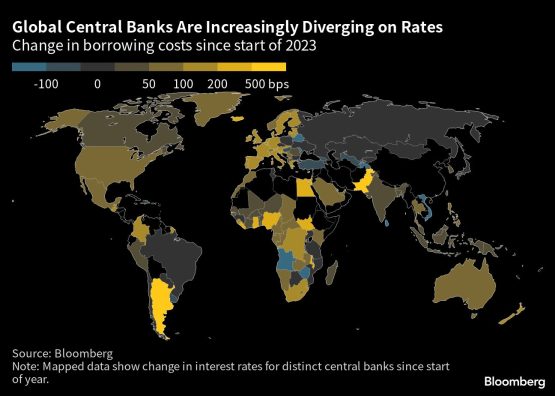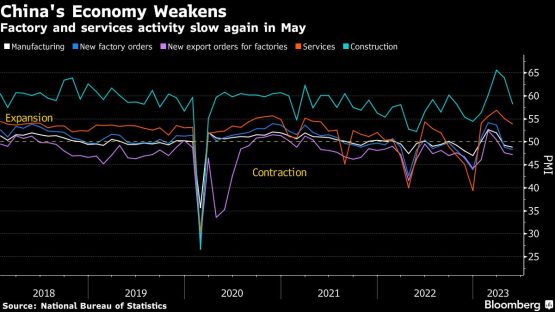China’s economic recovery is in danger of sputtering after figures this week showed a further contraction in manufacturing and softer services activity.
In the US, job growth and vacancies at employers exceeded forecasts, underscoring a still-robust labor market that’s bolstering the world’s largest economy.
While inflation in Europe cooled more than forecast, the stubborn nature of price pressures is likely to persuade central bankers to push ahead with higher interest rates.
Here are some of the charts that appeared on Bloomberg this week on the latest developments in the global economy:
Asia
China’s economic recovery weakened in May, raising fresh fears about the growth outlook and prompting calls for more central bank action to counter the downturn. Manufacturing activity contracted at a faster pace than in April, while services expansion eased.

A peek at five often overlooked raw materials markets shows how China’s stuttering recovery extends to almost every nook and cranny of its economy. Futures markets for items as diverse as glass, styrene and corn starch are piling on the evidence that China isn’t recovering as fast as many people had hoped.

China is working on a new basket of measures to support the property market after existing policies failed to sustain a rebound in the ailing sector, according to people familiar with the matter.

Australian approvals to build new homes tumbled to the lowest level in 11 years, driven by fewer permits for apartment buildings, suggesting weak residential property investment will continue to drag on the economy.
US

The latest US jobs report presented conflicting signals on a heretofore robust labor market: hiring that exceeded expectations and a jump in the unemployment rate. Economists said they saw more reason than not to believe the labor market is still humming.

Job openings at US employers unexpectedly surged in April to the highest in three months. The number of vacancies increased to 10.1 million, exceeding all estimates.

Most Americans are alarmed by the level of US government borrowing. Treasury Secretary Janet Yellen isn’t one of them. Instead of looking at the pile of outstanding bonds as a share of the economy’s output, she prefers the ratio of interest payments — crucially, after adjustment for inflation — to GDP. So far, the larger public debt load hasn’t imposed much of an interest burden.

Europe

Underlying inflation in the euro zone dipped by more than expected, though European Central Bank President Christine Lagarde said there’s “no clear evidence” that it’s peaked and pledged to lift interest rates further. Consumer prices excluding items like fuel and food advanced by 5.3% from a year earlier in May — down from April’s 5.6% increase and less than forecast.

Russian crude oil flows to international markets are edging lower, but still show no substantive sign of the output cuts that the Kremlin insists the country is making.
Emerging Markets

Brazil’s economy roared back in the first months of 2023, lifted by bumper harvests that outweighed the drag of double-digit borrowing costs. However, few see it lasting.
World

Thailand’s central bank raised its key interest rate to the highest level in eight years, and Liberia, Gambia and Lesotho also hiked borrowing costs, while Sri Lanka unexpectedly cut its benchmark for the first time in nearly three years.
Additional reporting by Swati Pandey, Andrew Rosati, Augusta Saraiva, Zoe Schneeweiss, Fran Wang, Heng Xie, Leda Alvim, Alfred Cang, Sarah Chen, Christopher Condon, Andrew Langley, Julian Lee, John Liu and Monique Vanek.
© 2023 Bloomberg

